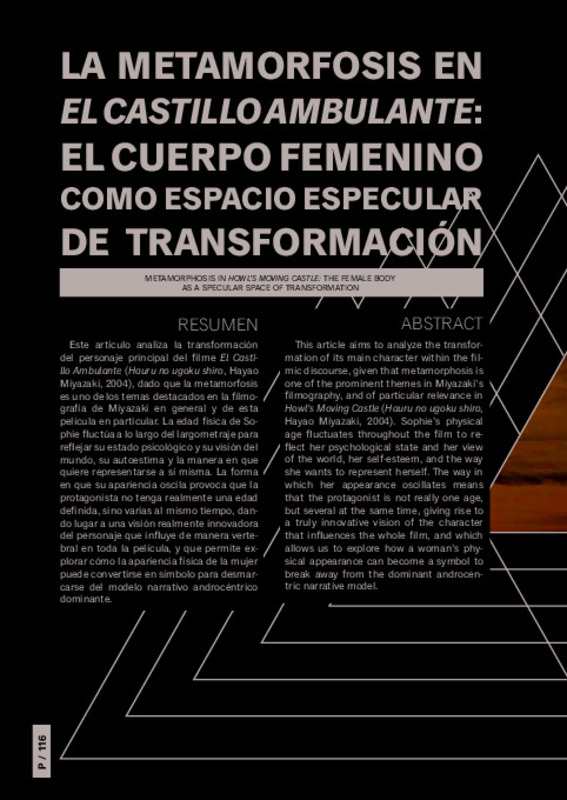AGUADO PELÁEZ, Delicia; MARTÍNEZ GARCÍA, Patricia, 2016. “El modelo femenino en Studio Ghibli: un análisis del papel de las mujeres en Hayao Miyazaki”, en GÓMEZ ARAGÓN, Anjhara (ed.), Japón y Occidente. El patrimonio cultural como punto de encuentro, Sevilla: Aconcagua Libros, pp. 203-212.La metamorfosis en El Castillo Ambulante: el cuerpo femenino como espacio especular de transformación
ATWOOD, Margaret, 1993. The Robber Bride, Toronto: McClelland and Stewart.
BAKHTIN, Mikhail, 1981 [1975]. The Dialogic Imagination, trad. inglés Michael Holquist y Caryl Emerson, Austin y Londres: University of Texas Press, (Voprosy literatury i estetiki, Moscú: Judozhestvennaia Literatura).
[+]
AGUADO PELÁEZ, Delicia; MARTÍNEZ GARCÍA, Patricia, 2016. “El modelo femenino en Studio Ghibli: un análisis del papel de las mujeres en Hayao Miyazaki”, en GÓMEZ ARAGÓN, Anjhara (ed.), Japón y Occidente. El patrimonio cultural como punto de encuentro, Sevilla: Aconcagua Libros, pp. 203-212.La metamorfosis en El Castillo Ambulante: el cuerpo femenino como espacio especular de transformación
ATWOOD, Margaret, 1993. The Robber Bride, Toronto: McClelland and Stewart.
BAKHTIN, Mikhail, 1981 [1975]. The Dialogic Imagination, trad. inglés Michael Holquist y Caryl Emerson, Austin y Londres: University of Texas Press, (Voprosy literatury i estetiki, Moscú: Judozhestvennaia Literatura).
BOURDIEU, Pierre, 2000 [1998]. La dominación masculina, trad. cast. Joaquín Jordá, Barcelona: Editorial Anagrama (La domination masculine, París: Éditions du Seuil).
BUTLER, Judith, 1990. Gender Trouble: Feminism and the Subversion of Identity, Nueva York: Routledge.
DE LAURETIS, Teresa, 1992 [1984]. Alicia ya no, trad. cast. Silvia Iglesias Recuero, Madrid: Cátedra (Alice Doesn’t, Bloomington: Indiana University Press).
FRASER, Nancy, 2011. Dilemas de la Justicia en el Siglo XXI. Género y globalización, Palma de Mallorca: Universitat de les Illes Balears.
HAUKE, Christopher; ALISTER, Ian, 2001. Jung and Film: Post-Jungian Takes on the Moving Image, Londres: Psychology Press.
HUTCHEON, Linda, 2006. "Postmodernism", en WAKE, Simon, MALPAS, Simon (eds.), The Routledge Companion to Critical Theory, Londres: Routledge, pp. 120-130.
KÜBLER-ROSS, Elisabeth; KESSLER, David, 2014 [1969]. On Grief and Grieving: Finding the Meaning of Grief through the Five Stages of Loss, Nueva York: Scribner (On death and dying, Nueva York: The Macmillan Company).
LAPSLEY, Rob, 2006. “Psychoanalytic Criticism”, en WAKE, Simon, MALPAS, Simon (eds.), The Routledge Companion to Critical Theory, Londres: Routledge, pp. 73-86.
MULVEY, Laura, 1975. “Visual Pleasure and Narrative Cinema”, en Screen, vol. 16, pp. 6-18.https://doi.org/10.1093/screen/16.3.6
NAPIER, Susan Jolliffe, 2000. Anime from Akira to Princess Mononoke. Experiencing Contemporary Japanese Animation, Nueva York: Palgrave. https://doi.org/10.1057/9780312299408
RUÍZ OLABUÉNAGA, José Ignacio, 2012. Metodología de la investigación cualitativa, Bilbao: Universidad de Deusto.
SEGURA, Eduardo, 2017. “Mesa Redonda: El Norte en la Obra de Tolkien”, en III International Conference of the Inklings and the Western Imagination, Vitoria: Universidad del País Vasco.
WOOLF, Virginia, 2017 [1929]. Una habitación propia, trad. cast. Laura Pujol, Barcelona: Planeta (A Room of One’s Own, Londres: The Hogarth Press).
[-]









